EZ Generator Switch
Owner, patent holder
- Joined
- May 2, 2022
- Messages
- 43
Disclaimer: I am not here to pass judgement on any company selling power supplies I am here to inform you of facts that we know are true. So...Before you purchase a power supply such as Eco flow, Jackery, Renogy etc...that you wish to connect to any transfer switch. You need to be aware some equipment will not work with certain other pieces of equipment that you want to energize. None of the issues are related to any transfer switch. A transfer switch doesn't know if it passing along dirty current or if its passing along a floating or Bonded system...its just transferring what you provide. We go thru this day in day out , customers purchase a power unit and it will not run their furnace or other specific equipment. They contact us for help thinking its a transfer switch issue, bad news...its the unit you purchased! They just didn't tell you before your purchased your power supply system, It will NOT energize lets say your furnace due to their configuration and the requirements of your equipment.
We spend hours chasing these companies trying to get answers for our customers...trying to help anyway we can. Many companies don't have employees that even under stand there are two basic systems. Floating and Bonded neutral systems, so you might as well be talking to the wall. Or they suggest using a neutral bonding plug>>> news flash they are not legal, they may have a label but the NEC is very clear about how & where you bond a neutral and it is not downstream away from the panel, ever. Simply put you want all unbalance of a system to flow back on the neutral to the source not flow back on the ground wire. Grounds are there for fault current only, unless there is a fault it should NEVER have current on it.
If a company is telling you a neutral bonding plug is OK then its OK to bond their "neutral" in a transfer switch. The difference is the transfer switch is bringing their neutral all the back to the source ( per the NEC) and at that location it is bonded to ground, not downstream somewhere.
So, you spent $$ on a system that will not power your Lennox, Buderus, Trane and some microwaves. Fact is, any system that is searching for a neutral that is bonded to ground, flame rectification system, voltage gradient between neutral and ground will not run, Please don't blame the transfer switch its doing its job. Please do your homework, be certain their neutral in their system can be connected to the house system neutral and you will avoid problems.
If you know the system you purchased works because their neutral is bonded to the house system neutral via a transfer switch you may want to post that info to help others. To date we have found Eco-Flow, Renogy, Growatt thru our customer base are working.
Here is a response from Bluetti >
> Jackery has made it clear to several of our customers...They do not want their system connected to the house neutral system. Jackery, unless they changed their mind will not work with certain equipment.
We spend hours chasing these companies trying to get answers for our customers...trying to help anyway we can. Many companies don't have employees that even under stand there are two basic systems. Floating and Bonded neutral systems, so you might as well be talking to the wall. Or they suggest using a neutral bonding plug>>> news flash they are not legal, they may have a label but the NEC is very clear about how & where you bond a neutral and it is not downstream away from the panel, ever. Simply put you want all unbalance of a system to flow back on the neutral to the source not flow back on the ground wire. Grounds are there for fault current only, unless there is a fault it should NEVER have current on it.
If a company is telling you a neutral bonding plug is OK then its OK to bond their "neutral" in a transfer switch. The difference is the transfer switch is bringing their neutral all the back to the source ( per the NEC) and at that location it is bonded to ground, not downstream somewhere.
So, you spent $$ on a system that will not power your Lennox, Buderus, Trane and some microwaves. Fact is, any system that is searching for a neutral that is bonded to ground, flame rectification system, voltage gradient between neutral and ground will not run, Please don't blame the transfer switch its doing its job. Please do your homework, be certain their neutral in their system can be connected to the house system neutral and you will avoid problems.
If you know the system you purchased works because their neutral is bonded to the house system neutral via a transfer switch you may want to post that info to help others. To date we have found Eco-Flow, Renogy, Growatt thru our customer base are working.
Here is a response from Bluetti >
- Bluetti replied "Sorry that our power station is floating grounded. You need to buy a neutral plug."
> Jackery has made it clear to several of our customers...They do not want their system connected to the house neutral system. Jackery, unless they changed their mind will not work with certain equipment.




